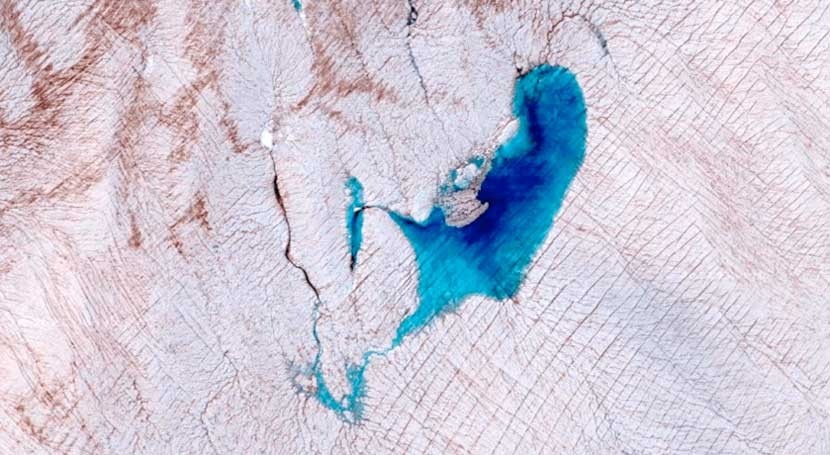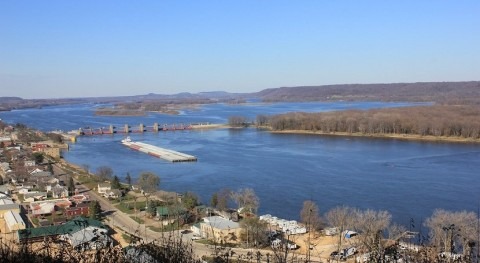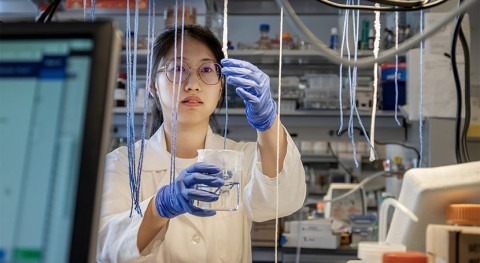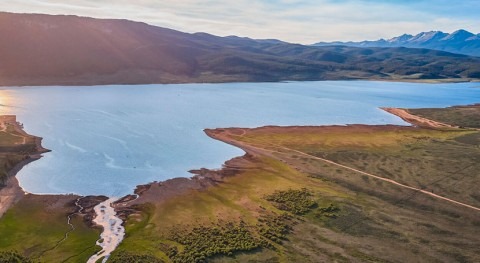Water “blisters” trapped beneath the thick interior of Greenland’s ice sheet could provide critical insight into the hydrological network coursing deep below Earth’s second largest body of ice — and how it might be destabilized by climate change, according to a new study.
Each year, thousands of natural meltwater lakes form on the surface of the ice sheet’s high-elevation interior, where ice can be more than a half-mile thick. As these lakes drain, they form large water-filled cavities between the ice and the bedrock.
By combining field observations with mathematical models and laboratory experiments, Princeton University-led researchers discovered that these blisters push the surface of the ice upward, then cause it to gradually drop down as the water permeates into the subglacial drainage system, according to a report in the journal Nature Communications.
The team shows for the first time that the rise and fall of the ice sheet caused by rapid lake drainages can be used to estimate a property known as transmissivity, which characterizes the efficiency of the water networks that form between the ice and the bedrock. Lake drainage presents a new tool for gauging transmissivity beneath inland regions of the ice sheet, where transmissivity is otherwise difficult to measure, the researchers reported. They found that transmissivity can increase by as much as two orders of magnitude during Greenland’s summer melt season.

The findings could shed light on how climate change will affect Greenland’s vast frozen interior as the planet warms and surface melting increases, said first author Ching-Yao Lai, an assistant professor of geosciences and atmospheric and oceanic sciences at Princeton. Water from surface melting can act as a lubricant, she said, causing the glacier to slide more easily across the bedrock.
Existing research has shown that a major way for surface melting to impact the stability of the Greenland ice sheet is by meltwater lubricating the ice-sheet bed, Lai said. The majority of these studies, however, have focused on low-elevation areas where the ice sheet is thinner. Previous studies also have suggested that increased surface melt could accelerate the velocity of the high-elevation, interior ice sheet, but these findings are based on computational models, rather than observations, Lai said.
The paper in Nature Communications provides a rare, observation-based glimpse into the largely inaccessible water networks underlying Greenland’s high-elevation ice sheet. The study was supported by Princeton’s High Meadows Environmental Institute (HMEI) and the HMEI Carbon Mitigation Initiative.
“We know that as the climate warms in the future, the surface melt zone can expand and migrate to higher elevations than currently observed. A big question that remains to be answered, however, is how much transmissivity can increase further inland,” said Lai, who is an associated faculty member in HMEI.
“A potential impact is that the link between surface melt and subglacial water-network development could be activated not only at lower elevations, as currently observed, but also at higher elevations,” she said. “More observations of seasonal changes of subglacial transmissivity in response to surface melting would be needed to really understand what would happen when melt migrates to higher elevation regions.”

Co-authors of the paper from Princeton are HMEI associated faculty member Howard Stone, Princeton’s Donald R. Dixon ’69 and Elizabeth W. Dixon Professor of Mechanical and Aerospace Engineering and chair of mechanical and aerospace engineering, and Danielle Chase, a graduate student in Stone’s Complex Fluids Group.
The study co-authors also included Laura Stevens, an associate professor of climate and earth surface processes at the University of Oxford who has extensive experience studying lake drainages and ice dynamics. Stevens helped collect the field observations in Greenland with co-authors Mark Behn, an associate professor of earth and environmental sciences at Boston College, and Sarah Das, an associate scientist at Woods Hole Oceanographic Institution. Timothy Creyts from the Lamont-Doherty Earth Observatory at Columbia University also is a co-author on the study.
The researchers used GPS data and field observations of five lake-drainage events that occurred between 2006-12 to estimate drainage volume and to observe surface displacements caused by lake drainage and subsequent blister formation.
“We observed in the GPS data a wide range of ice-sheet uplift relaxation times following the five drainage events,” Stevens said. “We had an inkling that this spread in relaxation times might be indicative of some characteristic of the subglacial drainage system. Our understanding was significantly improved as this collaboration between researchers with expertise in observational, theoretical and experimental approaches catalyzed.”
Chase — who received a HMEI Walbridge Fund Graduate Award to study fluid-driven fracturing — then designed a series of experiments using a type of silicone that mimics the deformable ice overtop a porous material that represents the bedrock. She injected fluid between the deformable sheet and the porous substrate, observing the time it took for a blister to form and then drain into the porous substrate. Working with Stone and Lai, Chase also developed a mathematical model that explains the physics that govern the surface uplift and relaxation due to water blister formation. Her work is the topic of a paper recently accepted by the journal Physical Review Fluids.
“Experiments can be helpful because, in the lab, we can control and measure all the parameters in the system, which allowed us to test our model,” Chase said. “We also can choose ideal materials. The system is small enough to be held in one hand and the material is transparent, so we were able to directly observe the shape of the blister and the drainage into the porous substrate over time.”
The study is unique for using laboratory experiments to investigate natural processes such as blister formation that are difficult to analyze in the field where researchers cannot control the parameters.
“It is valuable to have laboratory models to better understand the mechanisms behind the complex shape changes that occur in nature,” Stone said. “Here, the laboratory experiments captured the main mechanical features observed in the field and helped us understand the relaxation of the ice sheet as water drains along the glacial bed.”
The paper, “Hydraulic transmissivity inferred from ice-sheet relaxation following Greenland supraglacial lake drainages,” was published June 25 in Nature Communications. The work was supported by Lamont Postdoctoral Fellowships from the Lamont-Doherty Earth Observatory; a National Science Foundation (NSF) Graduate Research Fellowship; the NSF Office of Polar Programs (OPP-1643970) and Cryospheric Sciences Program (OPP-1838410, ARC-1023364, ARC-0520077, and NNX10AI30G); NASA (NNX16AJ95G); the Vetlesen Foundation; the High Meadows Environmental Institute and the HMEI Carbon Mitigation Initiative at Princeton University; and the Princeton University Library Open Access Fund.


















